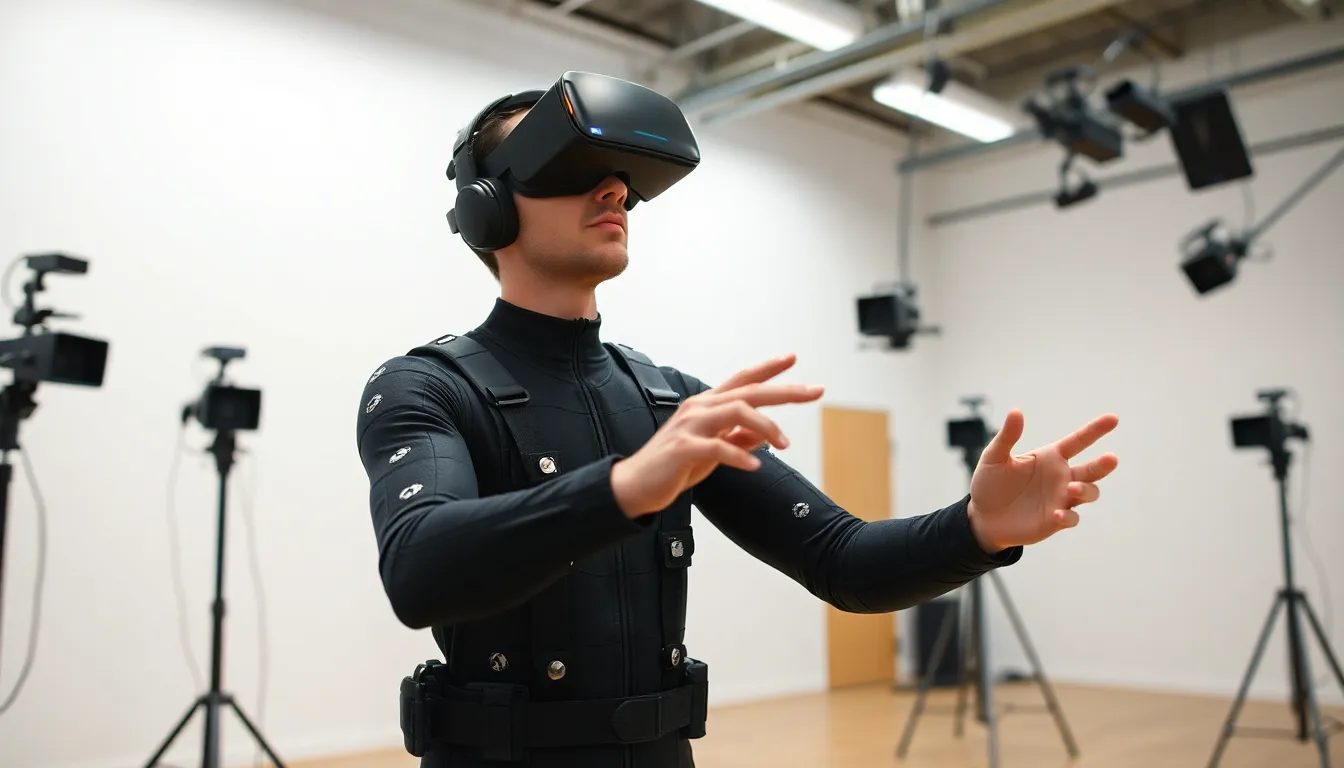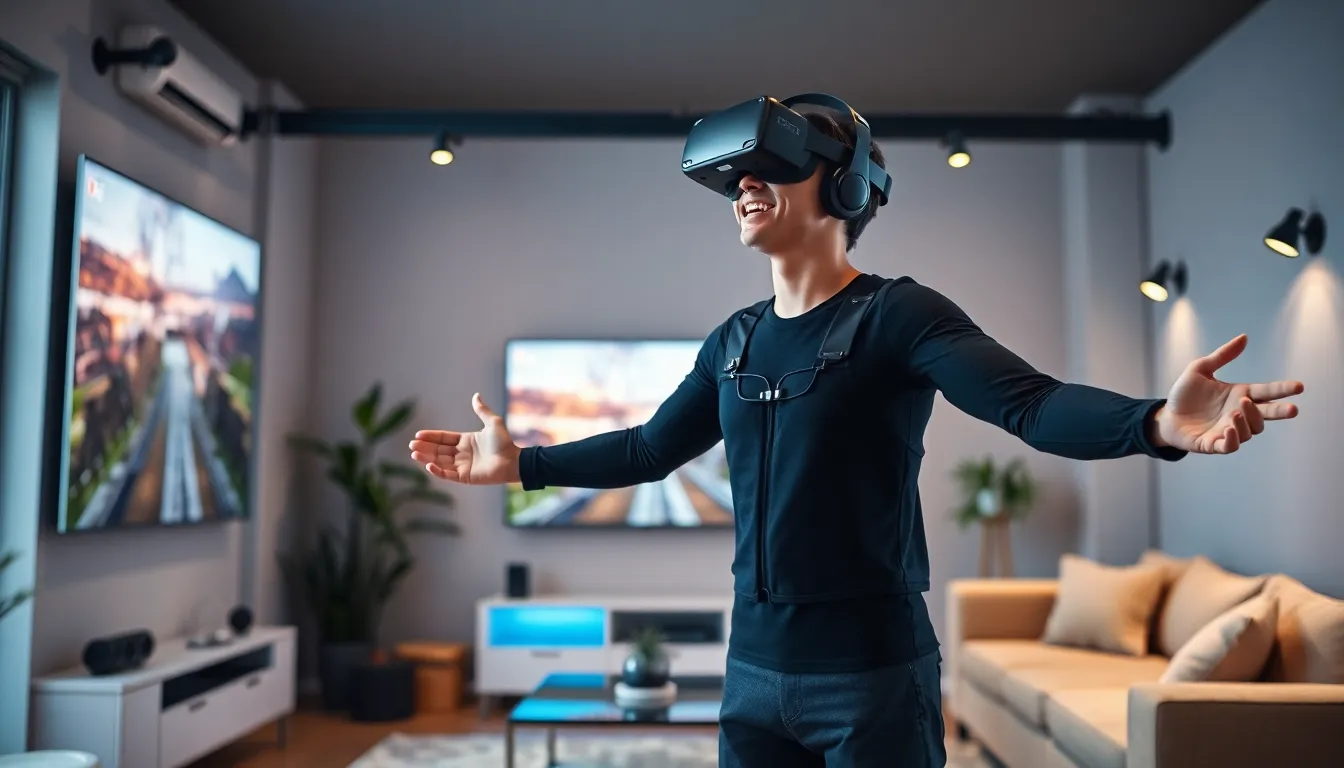Imagine stepping into a virtual world where every move you make is mirrored in real-time, making you feel like a superhero or a dance sensation. VR full-body tracking isn’t just a tech buzzword; it’s the magic wand that transforms your gaming and fitness experiences. Gone are the days of flailing around like a chicken—now, you can strut your stuff with precision and flair.
Table of Contents
ToggleOverview of VR Full-Body Tracking
VR full-body tracking enhances virtual experiences by allowing users’ movements to be replicated accurately in digital environments. This technology transforms interactions in gaming and fitness, creating a more immersive experience.
What Is VR Full-Body Tracking?
VR full-body tracking involves capturing a user’s entire body movements and translating them into a virtual space. Using sensors, suits, or cameras, it tracks limbs, heads, and torsos, ensuring movement fidelity. Technology options range from dedicated motion capture systems to affordable alternatives like camera-based solutions. Data collected offers real-time feedback, facilitating a seamless experience for the user.
Importance of Full-Body Tracking in VR
Full-body tracking in VR amplifies user engagement by making actions feel natural. Enhanced movement precision promotes physical interactions, leading to better gameplay and workout results. Immersive environments allow for realistic actions, forging a deeper emotional connection to experiences. Fitness applications particularly benefit, encouraging users to maintain an active lifestyle through engaging workouts. Ultimately, the technology enhances social interactions within shared virtual spaces, fostering community and collaboration.
Technologies Behind VR Full-Body Tracking

VR full-body tracking employs multiple technologies to ensure accurate and responsive movement capture. Key systems include optical tracking, inertial tracking, and hybrid tracking solutions.
Optical Tracking Systems
Optical tracking systems utilize cameras to capture user movements in real-time. Users wear markers or suits equipped with reflective or colored surfaces. Cameras then capture these markers and triangulate their positions, allowing the system to interpret movements. This method benefits from high accuracy and precision, making it ideal for settings that require detailed motion tracking. However, it often requires a well-lit environment and is susceptible to occlusions, where objects obstruct the view of the cameras.
Inertial Tracking Systems
Inertial tracking systems rely on accelerometers and gyroscopes to detect motion. Users wear devices that record orientation and acceleration, generating movement data. This approach excels in portability and ease of use, functioning well in any environment without requiring external sensors. Nevertheless, inertial tracking may experience drift over time, leading to inaccuracies if not periodically recalibrated.
Hybrid Tracking Solutions
Hybrid tracking solutions combine the strengths of both optical and inertial systems. These systems integrate cameras with inertial sensors to enhance tracking accuracy and reliability. By using both methods, they compensate for each other’s weaknesses. For instance, while optical systems face challenges with occlusions, inertial sensors can fill gaps in data. Hybrid systems provide seamless transitions between different tracking environments, offering a versatile solution for various applications.
Applications of VR Full-Body Tracking
VR full-body tracking finds significant applications across various industries, enhancing user interaction and engagement.
Gaming and Entertainment
Gaming experiences thrive on VR full-body tracking technology. It allows players to physically engage with virtual environments, enhancing immersion. Gamers benefit from lifelike simulations that replicate their movements. Multiplayer solutions create social interactions, making games more engaging and fun. Popular titles utilize this technology for realistic gameplay, attracting a larger audience. Players report increased satisfaction and enjoyment, showcasing its impact on their overall experience.
Health and Fitness
Fitness applications leverage VR full-body tracking to promote active lifestyles. Users enjoy interactive workouts that mimic real-world activities. This technology provides immediate feedback, helping users refine their movements and improve performance. Group fitness sessions in virtual spaces foster community and encourage collaboration. It also aids rehabilitation efforts by tracking progress in physical therapy. Many fitness enthusiasts embrace VR workouts as a motivating and engaging alternative to traditional routines.
Training and Simulation
Training simulations benefit immensely from VR full-body tracking solutions. Various industries use this technology for skill development and scenario-based learning. Professionals can experience realistic training environments that replicate real-life challenges. Participants improve decision-making skills and teamwork in virtual settings. Emergency responders, medical personnel, and military personnel rely on this technology to enhance preparedness. Enhanced realism in training scenarios leads to better outcomes in actual situations, ensuring higher competency and skill retention.
Benefits of VR Full-Body Tracking
VR full-body tracking transforms user experiences by creating a more engaging and interactive environment in virtual reality.
Enhanced Immersion
Immersion becomes more profound with VR full-body tracking. Users experience a deeper connection to virtual worlds when their entire body is represented. This realism makes it easier to forget about the physical environment. Games and applications feel more lifelike, leading to heightened emotional responses. Players often report a stronger sense of presence, making interactions feel genuine. In fitness, workouts become dynamic, helping users lose themselves in the activity. Real-time feedback enhances movements, making each action instinctive and responsive.
Improved Interactivity
Interactivity expands significantly through VR full-body tracking. Engaging with virtual elements feels more natural when body movements are accurately replicated. Users can reach, jump, and turn, enabling more dynamic gameplay and training scenarios. Cooperative experiences thrive, as participants communicate through body language and movement. Group activities often become more coordinated, enhancing social interaction among users. This interaction fosters teamwork and collaboration in gaming and fitness environments alike. Overall, meaningful connections emerge, allowing participants to enjoy shared experiences in ways traditional gaming cannot replicate.
Realistic Motion Capture
Realistic motion capture defines the capabilities of VR full-body tracking. Capturing users’ movements with precision creates authentic representations in virtual settings. High-fidelity tracking ensures that every gesture, from subtle head nods to energetic leaps, translates seamlessly. Applications can respond intuitively to user actions, enhancing the overall experience. Professionals can execute complex tasks in simulations, benefitting fields like medicine and emergency response. Improved capture accuracy encourages refined skills and decision-making, contributing to effective training and assessments. Achieving realistic motion enhances both gameplay enjoyment and skill development across various applications.
Challenges and Limitations
VR full-body tracking faces several challenges that can affect user experience and implementation.
Hardware Limitations
Hardware plays a crucial role in VR full-body tracking. Devices, often requiring high-end specifications, may not be accessible to all users. Many systems depend on multiple sensors or cameras to capture movement accurately. This dependency can limit portability and ease of setup in various environments. Moreover, tracking performance may decline in low-light conditions or congested spaces. Mobility, or lack thereof, becomes an issue when users need to maintain a clear line of sight with sensors. Achieving optimal tracking performance often requires significant investment in compatible hardware.
Calibration Issues
Calibration remains a significant concern in obtaining accurate body tracking. Users frequently spend time ensuring that sensors or cameras accurately capture movements. Improper calibration can lead to mismatches between intended actions and displayed responses. Such discrepancies disrupt immersion and limit engagement in virtual experiences. The need to recalibrate often arises with changes in environment or user position, adding to user frustration. Perfect calibration results in optimal tracking performance, but achieving consistency proves challenging under different conditions.
Cost Considerations
Cost poses a barrier for widespread adoption of VR full-body tracking technology. Comprehensive tracking solutions can involve substantial initial investment for quality hardware and software. Budget constraints limit access to advanced systems, particularly for casual users or smaller developers. High costs can also impact the affordability of VR setups for fitness and gaming applications, reducing user engagement and growth. Lower-cost alternatives might sacrifice performance and accuracy, further alienating users. As the market develops, a balance must be established between quality and affordability to facilitate broader use of this technology.
VR full-body tracking stands at the forefront of immersive technology. By enabling users to engage with virtual environments in a more natural and interactive manner, it enhances both gaming and fitness experiences. This technology not only fosters an active lifestyle but also promotes social interactions within shared virtual spaces.
As advancements continue to emerge, the potential applications across various industries will only expand. Overcoming current challenges related to accessibility and cost will be crucial for its widespread adoption. The future of VR full-body tracking promises to redefine how individuals connect with digital worlds, making experiences more engaging and impactful.




